"Is there a specific" safety "?" What is JAL's approach to absolute safety and the surprising fact that the captain of JAL pursuing safety talks about?

High safety is required for passenger aircraft that carries many passengers and luggage and flies through the skies of Japan and the world. Supporting the flight of such a passenger aircraft is a pilot, a mechanic, a ground staff, people who work daily in an airline company. What kind of thinking is being adopted in pursuit of infinitely continuing "safety", what can be said "safety" in the first place In fact, you can interview a person who is actually fighting pilots and others in JAL There was an opportunity, but I was able to hear a really interesting fact there.
Safety Efforts | Safety & Operation Information | JAL Corporate Site
http://www.jal.com/ja/flight/safety/
In this time, I was able to interview people who are engaged in pilot training, mainly about JAL (Japan Airlines) 's efforts on safety promoted. When I entered the building of JAL in Haneda airport which I visited for an interview, I encountered an object which shaped a crane like JAL. It is what it was manufactured using parts "engine blade" inside the engine which is no longer used anymore. I suddenly encountered an object that shoots out an airplane love heart with a single shot. Also, on the day, we were able to step into the area where ordinary people can not usually enter.

JAL's Captain Tsuruya who was able to hear the story this time. In addition to serving as the captain in the Boeing 777 aircraft, he is currently in charge of rearing training and public relations work, and this time JAL thinks "safe" and what various kinds of things are adopted for realization I was able to hear a part of the initiatives.
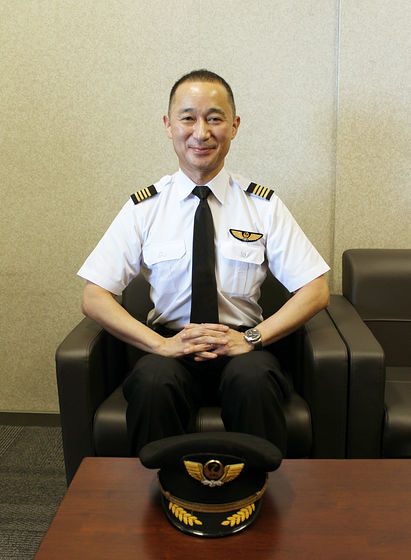
◆ "What is" safety "?"
Captain Yuya tells us that there are many people who think that "Pilot's job," generally speaking is "maneuvering an airplane," but that is not the only thing in fact. " Although it can be said that it is common to imagine things like grasping the control stick and maneuvering what is associated with the work called pilot, the captain ordered the real contents, "Piloting the airplane is a pilot It is only part of the job of the pilot, and the work of the pilot is "safety management of the aircraft under operation". And then I asked the editorial staff questions like Zen questioning what the identity of safety is like.
Captain Masaya (hereinafter "Kusaya"):
Here I would like to ask one, but can you imagine "dangerous things" first? Regardless of the airplane, whatever you want can be used as long as it is personal belongings.
GIGAZINE ("G" below):
Well, I think there are many things ...... For example, a knife, an accident ... ... In some cases "people" may lead to danger.
Yoshitani:
Well, I think that we can come up with various things, but on the contraryWhat specific concrete "safety" is, can you give specific examples?
...... This is GIGAZINE editorial staff who noticed the hurdle as asked. Certainly, "dangerous things" easily comes to mind, but when it is said that "safe things", it is surprisingly impossible to think of anything. Even though it is said to be "safe", such as automobiles and trains, tools usually used, electricity, gas stove, etc., there seemed to be a "danger" always present side by side at some proportion.
G:
No, I can not imagine anything ... ... In other words, will it be said that there is no dangerous thing?
Yoshitani:
That's right, as I thought, there is no concrete thing to say "safety" in fact. There is a concrete thing in danger. However, there is nothing concrete in terms of safety, and "being in one state" is called safe.
This is not JAL's own saying, it is an organization related to international civil aviationICAO(International Civil Aviation Organization). Safety is defined as "risk factor (hazard) identification and continued risk management, risk of human injury or loss to property is acceptance level It is defined as "a state where it is reduced to less than the acceptance level".

Yoshitani:
In other words, safety means "Acceptable riskThat's what it means. In the situation that you decide what is dangerous and keep it to an acceptable level, it means that this is "safe". So it is natural that you can not think of anything concrete as you asked "What is safety?" Safety means that it is a certain "status (situation)", "stage" or "state", and we are engaged in daily work to pursue them .
G:
When you show it to your eyes again, the definition of safety is what is expressed like this.
Yoshitani:
That's right. Often sometimes referred to as "pursuit of absolute safety", this is certainly considered to be the most important thing in JAL. It is correct as a corporate philosophy, direction and goal, but its realization may be inherently impossible. In other words, absolutely safe means that we are keeping track of our efforts to establish absolute safety. So it is no use at the moment when I thought "It is safe with this already". For that reason, it is JAL's efforts to safe to do the training of the crew and others firmly.
◆ Train crew training
In the place where I realized again the simple but vital point that the essential meaning of "safe" to be noticed once again, and that we must always continue our efforts on safety to keep that state, next time I talked about real training etc.
Yoshitani:
There are many stages before becoming a pilot. Immediately after joining the company, he or she conducts practical training on ground work and after joining the company, acquires the first officer 's qualification through the basic process from the second year and experiences the actual flight as the first officer. After that, it is a general pilot training course that you enter the training course as a captain, acquire qualifications and become involved in the business as a captain.
In obtaining the first officer's qualification, it is the "two kinds license" conventionally referred to as the license of a carPilot for businessI needed a qualification. This is not limited to pilots of airlines (airline companies) but has versatility, and it is qualified for use in jobs such as sightseeing flight and agricultural chemical spraying. However, this qualification included many matters concerning 'Skills that a pilot can fly alone' which is not necessary as a pilot of the airline.
So from 2013, it is a new airline pilot qualificationRegular transportation pilot(Multi-crew Pilot License:MPL) Was established, in JALIntroduced MPL training from 2013Did.
(Attachment) "Comparison between MPL Training and Conventional Method"
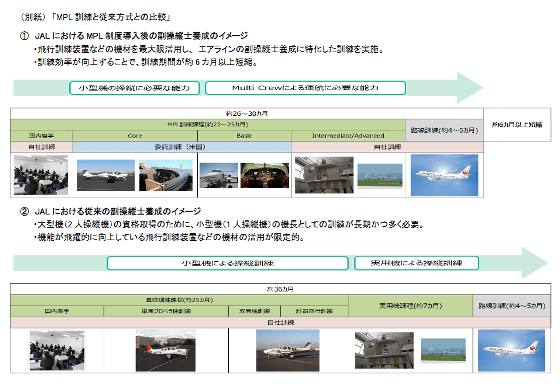
Yoshitani:
As a result, the duration of training will be shortened as a result. Nonetheless, this is not aimed at shortening the period or reducing costs. In fact, we anticipate that time and cost will be higher than in the past for the first few years after introduction. So why did you choose this qualification, that is why we thought that this method was the best for aiming at quality as JAL.
In addition to this, in order for the pilot to maintain the qualification and carry on the office, it is necessary to continue to receive the following training and examination every year.
1. Periodic review:Three times a year 2 times simulator + 1 examination on a route
2. Regular training:3 times a year Simulator
3. Aeronautical examination:Once a year (essentially twice a year)
Four. Regular Rescue Training:Once a year
Five. CRM(Crew Resource Management: Team performance training): Once a year (integrated into simulator training)
G:
When I look at this, I still have a hard training for the pilot's qualifications, so I know that I have to study all the time .... How do you say, the pilot people are serious.
Yoshitani:
It is serious. However, we think from the user's point of view, "I want you to keep this much for me, do not you think?" When I land at one airport, "I remember so, I do not think we want to ride much on an airplane piloted by the pilot that it's been five years since I landed at this airport" (laugh).
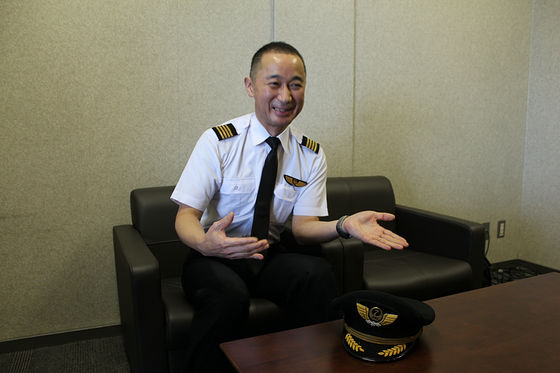
Yoshitani:
I use a simulator in training, but actually I will not practice takeoff and landing here. Because it is a pilot, there are circumstances that have the ability to take it for granted. Actual practice training is roughly divided into two categories: "situation for serious trouble" and "situation with very bad weather."
A serious malfunction is, for example, when one of the engines stops, the hydraulic system for manipulating the aircraft breaks down, or a hole is opened in the aircraft while flying over the sky, sudden depressurization occurs It is such a case. And, the very bad weather situation is, for example, a situation where fog occurs and the visibility gets worse, strong crosswinds are occurring. Whether you can safely land an airplane when these conditions occur, or if you can interrupt takeoff during takeoff, you will be questioned in the training.
In the training using the simulator, we do all the things decided by the law, but here "CRMWhat becomes important becomes important. This is aimed at preventing "human error" which can be a cause in the event of an accident, but the trend of the airline industry in the future will be heavily involved.
◆ To increase the safety of expanding airline industry
In the aeronautical industry where future increases are surely taken, taking all measures to reduce the number of accidents is a necessary action to realize "safety". Next I asked about the contents of such a way of thinking.
Yoshitani:
CRM is an acronym for Crew Resource Management, which in JAL comply with international standards and is "in order to achieve safe and high quality operation, all available Effective utilization of human resources, hardware, and information ". "Human resources" here includes aircrew crews, cabin crew, flight managers, mechanics, air traffic controllers, and so on.
Looking at this sentence, it may seem like "Why, is it natural?" (Laugh), in fact this is commonplace. In JAL, it is the basis of our approach to say, "Write what you normally do is ordinarily written and protected exactly". And this has to be "visualized" in a "rational" and objectively. Why is this done because there are circumstances where the future aviation industry will go forward.
Since airplanes were invented by Wright brothers, the safety of airplanes has improved dramatically. At first it was not good to make the airplane itself, so we improved this. Still, an airplane accident happened. It was caused by the fact that facilities were not maintained, so we flattened the runway and paved it properly. And a control tower was made, and it was able to exchange wirelessly. Where equipment began to be set up, we improved the performance of the radio this time. Furthermore, by enriching the wireless facilities, it became possible to fly safely using radio waves even if the visibility is not good.
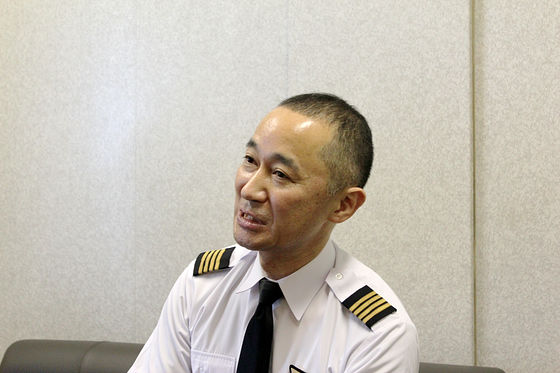
Yoshitani:
And the big one was the appearance of a simulator that can simulate the state of flight in a pseudo manner. By doing this, the content of training improved and skills could be improved. In this way, the safety of the aircraft has greatly improved as a result of overall efforts on safety, but inevitably the accident never became zero.
On the other hand, however, the number of departure flights of passenger aircraft that actually fly with people increases steadily as the year passes. Therefore, despite the fact that the accident occurrence rate is decreasing, the number of accidents occurring in the year is small, but it is on the whole increasing.
And in the future the number of passenger aircraft is expected to increase further. As of 2004, it is estimated that the number of passenger aircraft, which was approximately 18,000 aircraft worldwide, will increase to about 32,500 aircraft, 1.7 times in 2021. If this happens, it is obvious that the number of accidents will increase as it is. However, we want to make this accident count as infinitely zero. However, limitations can be seen only by improving on the machine side. What I looked at was that "human error"Human FactorsThat is the place.
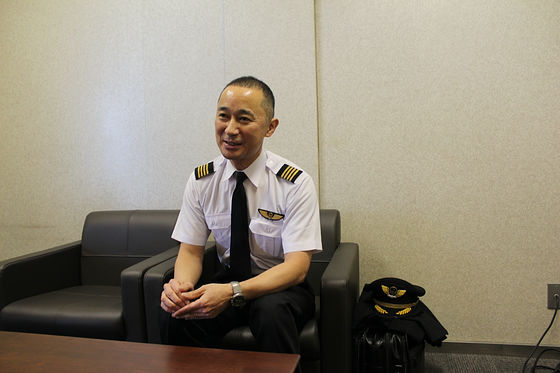
◆ "Tunneliff Airport Jumbo Machine Collision Accident" that informed the world of human errors
Here is the example of Human error as Capt. Hutoya was "Tenerife Airport Jumbo Machine Collision Accident" that occurred in 1977. This is because two large aircraft (Boeing 747 aircraft) collide on the runway and 583 people died, due to misperception of pilots and controllers involved in the operation and bad weather condition, Literally it is widely known as the worst airplane accident of the past. It seems that this accident is strongly recognized worldwide that it can not be avoided in order to tell the safety of aircraft.
Tenerife Airport Jumbo Machine Collision Accident - Wikipedia

This accident occurred because very unfortunate things overlapped. The accident occurred in Tenerife airport (Los Roodes airport) is one of the airports in the famous Canary Islands in the resort area, but in reality it was not the main airport that jumbo aircraft usually landed. However, as the main airport was closed due to the bombing terrorism, it was a situation that passenger aircraft carrying many passengers diverted (alternate landing) to Tenerife one after another.
After that, in response to the news that the main airport was restarted, the passenger aircraft that had been diverting to Tenerife flies to the original airport one after another, but fog has occurred in this Tenerife . Besides, Tenerife's air traffic controllers were not used to this situation at all. And despite the fact that one of the jumbo aircraft, which was in the process of moving to takeoff, is still on the runway, the captain of the other jumbo machine misunderstood as permission and started takeoff, and both aircraft were on the runway It was an accident that almost a front collision occurred.

ByAnynobody ~ commonswiki
Yoshitani:
The accident was directly attributable to the captain's belief, but attention was drawn to the question of why this could not be prevented, and attention was paid to human error and human factors. In addition, since we needed to take measures to lower the accident rate at the same time, attention to CRM has gathered, and JAL is also doing such efforts in JAL.
G:
That means that CRM has not started in recent years, but has been advanced from before.
Yoshitani:
That's right. This idea itself has attracted attention in the late 1970s. In JAL, in the mid-1980s Japanese carriers introduced CRM training ahead of other airlines. Even after that, we have been making efforts by updating the contents each time after various transitions.
Various efforts are being made in each country concerning this matter. The most interesting thing is that, as studies in various fields related to interpersonal relationship communication and cognition progress, in particular, it turned out that this problem was found to be closely related to various aspects such as maneuvering operation. With this awareness, it is about the past 20 years that the approach at the level of reviewing the overall training is needed.
G:
I think that it will be a very difficult task to systematize complicated things and incorporate them into education, but are the airlines considering their contents?
Yoshitani:
Various countries and institutions have been trying to improve this issue by repeating trials and errors. What is interesting is that there is not a decision to kill it. It is now that the government and the airline company have initiated efforts in Europe and research is progressing in the United States based on that, always making the most cutting-edge part by all means hard working. And now it can be said that it works in a good direction.
◆ Concept based on competency and concept of "non-technical skill"
Yoshitani:
As a result of such efforts, in the United States there has already been a history of more than 20 years since the beginning of the 1990s, "CompetencyThe idea based on "This is one that has been adopted in Europe around 2000.
In contrast to the fact that there was a thing called "airline pilot" at the arrival point where we had acquired a license in a build-up style so far,The pilot should have these abilitiesIt is the idea that we will acquire all the capabilities towards the point of arrival. This is exactly the same idea as "MPL (pilot for regular periodic transportation)" I mentioned earlier.
Traditionally, as a pilot's experience, and some "pilot statues" were created from among achievements, in the concept based on competency, "JAL's pilot shouldIt will mean that we have shifted to such a form, that we will acquire all the capabilities towards what we call it.
G:
Specifically, what kind of training is being done?
Yoshitani:
Actually, the training itself is defined in detail by law, and the content to be carried out is decided. In JAL, for the training of a certain subject, we set up a request to "this pilot as this JAL as far as possible" at the same time and confirm it. So, although you can not change the subject of the training itself, I am shifting the way of thinking and what I want for that person to a large extent.
As a concrete method, I will describe everything from the beginning to the end of what JAL calls for the pilot. This item has more than 1000 items.
G:
There are so many contents of pilot's work!
Yoshitani:
That's right. Then, for each item, decide on what condition and what level you must clear. And we have adopted a mechanism to check all that it keeps level properly by converting all this into a database. This is "a way of thinking based on competency", and it is already institutionalized in Europe and the United States. In Japan, it is not required as an institution, but JAL adopts this approach and incorporates the ability management into traditional training.
Although it becomes finer, the item of "competency" is "ICAO regulation"Knowledge(knowledge)""Skills(Skill)""Attitude(Attitude / posture) "is stipulated. Of these, Attitude originally needs to be owned by the pilot himself, and Knowledge is acquired by learning, but it is necessary to acquire about "Skills" and to "maintain" and "improve".
Skills is further divided into three categories: "Technical", "Procedural" and "Non-Technical". However, of these, "non-technical" was initially regarded as a separate item from the other two, and it was not considered to be the same line as the item of Skills.
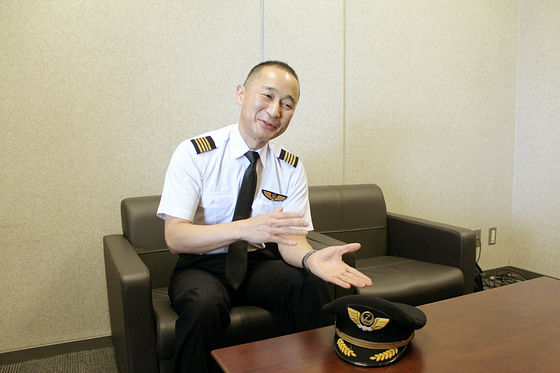
Yoshitani:
After the collision accident at Tenerife Airport Jumbo Machine I talked about earlier, airlines began thinking about various initiatives. Some of them were doing things like "psychological game". However, as we keep track of what we are going to do in actual work gradually, non skill content is also included in Skills and it seems to be regarded as "indispensable to pilot's abilities" It was.
In response to this, non-technical skills also set out detailed items just like other skills, created a checklist and evaluate it. This was a very big point. Evaluating non-technical parts is actually quite difficult, and not only JAL but also other airlines, as well as other companies around the world, like to evaluate non-technical parts of employees like this I think that it is a struggling part.
G:
Evaluation is difficult because it is a part invisible to the eyes.
Yoshitani:
Nevertheless, I think that it is still necessary to have the ability to sought and to challenge to evaluate it. Of course, we will explain so that we can gain understanding from ordinary employees in that evaluation, and we will approach to make it transparent.
All of these evaluations are managed in the database. When doing the evaluation, let's display what kind of ability is required for a certain item, for example "For example," There is room for improvement in this part of this subject, therefore, It is better to train a part a bit more ". If necessary, we will train again, and if it is approved, it will be reflected in the database.
In addition, since all of these information is on the database, it is possible to reference in real time any time via the VPN on the dedicated iPad owned by the flight crew.
G:
That means that everything is connected online
Yoshitani:
Evaluation of nontechnical skills is very difficult. In other words, it comes to get into the individual's way of thinking, and the instructor may be given an evaluation such as "If you keep that way of thinking, you will not let the captain of the whole age to take care of your entire lifetime." Although that is not the case. Absolutely not. In this evaluation, "Observable actsIt is necessary to evaluate based on. Otherwise, objective evaluation can not be done.
So what we do is create a list of "action indicators" that sets out what to do and what to do, to "take such actions". It does the same thing globally.
Among them, even under the circumstances, actual action examples of "you should take such actions" are clearly stated. Instructors are able to do guidance based on this, and as before, it has become ambiguous guidance that "You, you can not do it better, do better", but this time Based on the indicators, "It is requested that this is done in this scene, but you can not do it, act on this way." It is a big feature that you can specifically tell me that you act like this " is.
This indicator is used as a common language of evaluation in regular regular training, skill examination, everyday flight and so on.
G:
As it is very detailed items are set up, it is felt as if you say "You can become a pilot if you can clear all this," is not it?
Yoshitani:
Although it may be felt as very mechanical evaluation, it is not so. For example, even if there is a case where every item can act according to the indicator, there are times when it is not recognized that it acts in line with the index when looking at the whole. I think that it is the role of an instructor who is a human being to judge such a thing. Now that the simulator is progressing, the actions of each pilot can be taken with data. So, whether it is sufficient to do evaluation based on that data, it is not so, and still instructors and seniors see that person can embody JAL quality comprehensively, that kind of thing I value the importance of.
Therefore, what is being done in training "Captain Captain" to become the PIC is very strict. There is a comprehensive ability to see a really detailed part, and everyone is struggling. But because of that, I think that JAL quality is inherited from time to time.

G:
Even so, very fine details are stipulated.
Yoshitani:
Although it is stipulated in detail like this, this is simply "tool". In other words, it does not mean "any person can become a pilot when clearing this item", but these are essential conditions only. Those who embody "JAL quality" at JAL will serve them comprehensively, and they are doing such training to see human beings.
G:
Is everything for the realization of JAL quality?
Yoshitani:
That's right. I have a line that we expect, apart from the line that gets a license, it is included in the database requirement item that I mentioned earlier and it is required to comprehensively clear them .
Technical is necessary, natural, it is necessary to have procedure (procedure) and non-technical in a comprehensive manner, furthermore with Attitude (attitude), knowledge (knowledge) also wears the latest thing, such comprehensive We are aiming to have a competency, and even do as far as confirming it.
G:
So-called"PDCA cycle"is not it.
Yoshitani:
Yes, as I mentioned earlier, the evaluation system using the database introduced from Europe and the United States, the precondition that is the precondition is exactly that PDCA, especially in the field of aviation is called IDS (Instructional System Design). That is, it is "a continuous improvement process". When training is done with such a system, there is room for improvement, and trouble may be found. If it was before, it ended with "Would it be okay if you do not do it properly", but with this system always adding improvements, the cycle of evaluation and improvement is realized.
G:
When you are talking about stories, it is likely to be useful not only for the training of pilots, but also for general corporations other than that. Is there something useful in actual work?
Yoshitani:
As a way of thinking, it is not limited as it is a pilot. There are aspects that this work is easy to standardize that this concept is adopted in the pilot field in many cases. However, when talking about this story I will always say "It is possible to incorporate even other occupations". In fact, in the United States this scheme is not only used for pilots, but also for civic flight attendants and occupational people called "dispatchers" who are monitoring the flight operations.
Regarding the concrete merit, I think that this will result in effects in various places. But at least I can say that there is no teamwork that leads with a strong authority of the type called old capital captain style "Great Captain".
Hoshino President of "Hoshino Resort" said the same thing, but although there are certain positions and organizations among the company called Hoshino Resort, President Hoshino frequently said " It is a function, a person as an ability is a flat state "and that" the organization where the personnel is flat and functions are given to each person functions as the organization " I have the same way of thinking. In terms of pilot, PIC (pilot in command: so-called "Captain") and Kopai (so-called co-pilot) each fully satisfy the ability required for that position as a professional, I think that it means that you are doing a job as a function.
Nonetheless, when asked if the former "Great Captain" was inferior in safety, that is not the case. At the time there were still few traffic volumes, and the industry had plenty of room to tolerate such a constitution. However, as the traffic volume increases and the system becomes more complex, I think that it is said that such style in the past has become unfit for the present situation.

G:
The very impressive thing is that all people are appreciably evaluated to work in a healthy mental state in working as a member of the team. I feel that such a thing will accumulate and lead to improvement of the service as a company.
Yoshitani:
I am very glad when I feel like that (laugh). For example, when I go into a human dog and receive an exam, when I hear the result, I think that there are few people who think "I can not do that!" It is because judgment is made based on objective data, but it may be good if you think that it is close to it. I think that improvement of that person can not be expected unless it seems to be convinced of himself "You are so right ~".
G:
Besides that, is there a case where non-technical ability is useful in daily work?
Yoshitani:
Communication by language is also one of non-technical ability. This means "How to convey the necessary information to the other party accurately". Compared with Western languages, Japanese has structural characteristics such as "the subject is often omitted", "it is difficult to understand the conclusion if you do not tell the end of the sentence", so Japanese After recognizing the "ambiguity" that you have, you need training to communicate information properly.
Among them, the most outstanding thing is "numberingIt is a technique called. This is to tell the opponent first, saying "There are three major things I am about to speak from now." This is not easy before you get used to it, but it will show great effect when you can use it.
G:
Is it also useful during actual flight?
Yoshitani:
useful. While flying, we must talk with air traffic controllers and companies over the radio. Or you may interact with poorly performing text information rather than e-mails of mobile phones you usually use. In addition, now all the interaction with the cabin crew (CA) is over the intercom. Techniques become very important to efficiently and accurately convey information when there is no face in each other like this. Since interaction with the controller is standardized to some extent, it does not become a big problem. The problem is when it is like an emergency occurs. Since there is no time, we need to communicate information in a short conversation.
The interesting thing is, for example, that the order may change between telling the contents to the company that "This is starting descent, but such a shake is expected before landing" to the cabin crew. This is due to the situation of the cabin crew who talks while doing business, but under such circumstances, there are things that "the last thing you listen to is the most impressive" as human characteristics. Therefore, if there are three things to convey, the most important thing will be brought to the very end. In ordinary conversation, basically the most important thing is told first, but depending on the circumstances the technique is exactly opposite.
G:
Indeed, it is interesting.
Yoshitani:
In addition, there is also a training of information transmission in case emergency occurs, although it is not necessary. How the cabin crew speaks trains how accurately the information is transmitted to the pilot and how we can pull out the necessary information successfully, I train such things from the usual way.
G:
It is that it is not good at "Captain! It is serious!" (Laugh)
Yoshitani:
It's okay. I do not think there are flight attendants that report such reports (laugh). If such a report comes up, I think that you will use the technique to extract information after showing a surprising reaction of "What?!?"
However, it is extremely rare for such a situation to happen, so I hope that such training will be useless if possible, (laugh)
----
This is the end of the interview. After that, we were able to visit a part of the operations in the facility. This room is where the pilot who completed the show (show up) confirms the flight of the day. A monitor is placed on the table where many are put, and necessary information before the flight and the flight plan created by the flight manager (dispatcher) are confirmed.
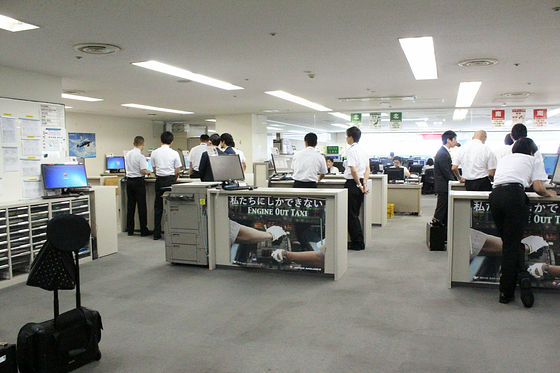
PIC (so-called captain) to check the condition of the weather and Kopai (so-called sub-captain). It is the captain Putinya who is manipulating the mouse in the center, with the captain's neck attached to the shoulders.

On the screen, you can check the state of the clouds captured by the weather radar, etc. It is also possible to grasp the state of the airflow predicted at the time of flight and the actual shake situation received from an airplane flying in front.
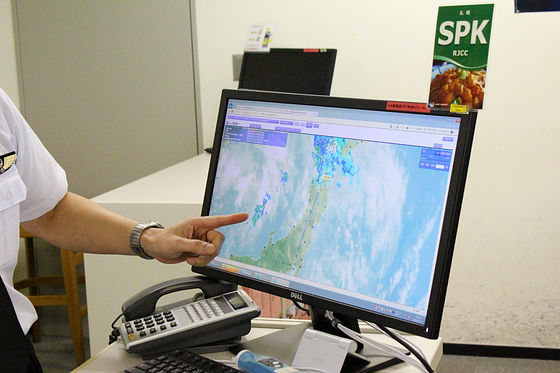
Moreover, it sometimes confirms by using the map "aerial chart" describing such air way.
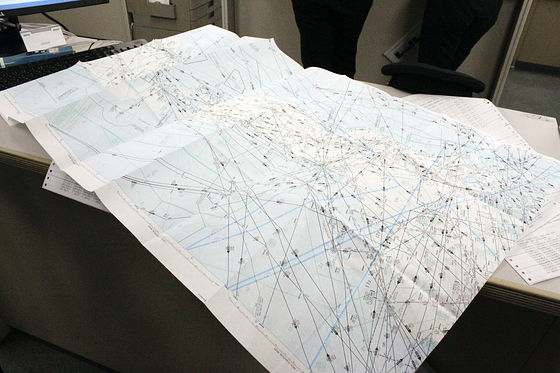
In the aerial chart, the route through which invisible planes pass is detailed.
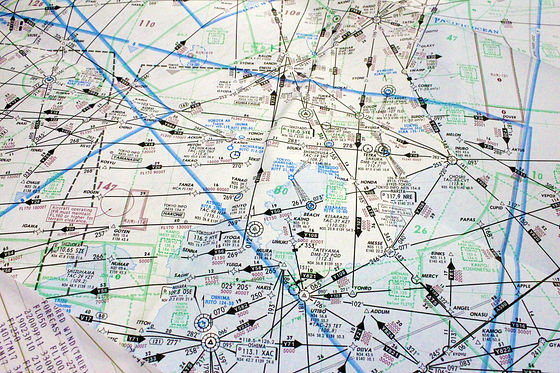
In this interview, I was able to listen to details of efforts with the person who can not see true identity, pursuing "safety" without appearance. Interestingly, this is not the case only for airline companies, it seems to be said that it is a versatile content in any kind of industry at some level. Although it can be said that anyone can take similar ideas and improve their work, it was a content that was surprised by the size and systematic realities actually adopted by JAL.
Also, it was impressive that the explanation of Mr. Hataniya, who is spoken very stagnantly, was very easy to understand. I was sure that this was an effect that had been trained in the "transmitting technology" which was talked about in the interview, but I left behind Haneda Airport.
Related Posts:







